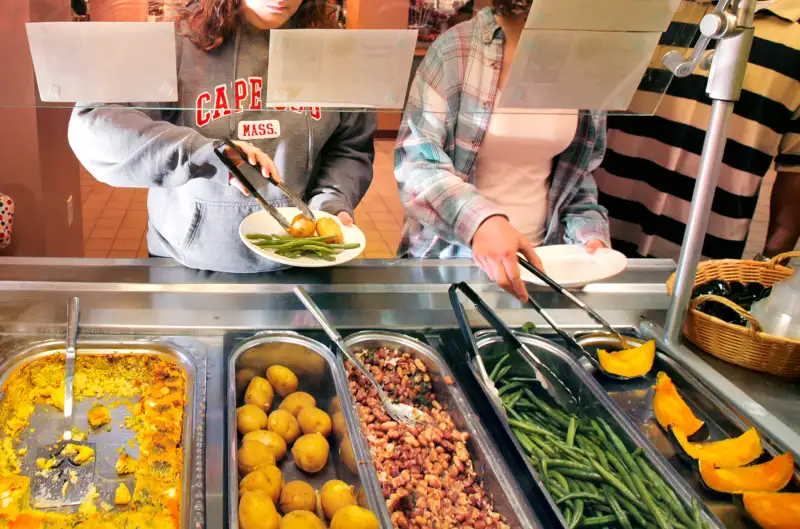Here's Why Food Is So Insanely Expensive at College

If you’re wondering why college costs so much these days, take a look at the main dining hall at Wellesley College. The $65 million Lulu Chow Wang Campus Center features floor-to-ceiling windows through which students can admire Lake Waban while enjoying made-to-order omelets for breakfast, Niman Ranch ham sandwiches for lunch, dinner entrees featuring local seafood, and, for dessert, all-you-can eat ice cream.
Wellesley, in Wellesley, Mass., requires all undergraduates to buy a contract for the dining hall. The cost: $7,442 per year, or almost $12 per meal. That’s almost three times more than the money spent by the average American cooking at home.
“Sometimes I look at the meal I’m eating and I’m, like, 'I have two eggs and toast. This is not worth $12,'” says Mieke Bovbjerg, a 19-year-old sophomore from Pittsburgh.
Wellesley is an extreme example of a trend that is one of the most surprising contributors to the expense of college: cafeteria costs. The price of a typical college dining hall contract has jumped 47% in the last decade, federal data show. Meanwhile, overall food costs across the nation rose only 26% over the same period, the government says. As a result, undergraduates who buy dining contracts for their college cafeteria today typically spend much more on food than do Americans who eat at home.
Related: Students, feeling nickel-and-dimed, force new scrutiny of college fees
Data on campus dining contracts collected by the U.S. Department of Education show that the average college charged about $4,300 for a 19 meal-per-week contract for the 2015 academic year. Since the typical academic year is made up of two 15-week semesters, that averages out to about $7.50 per meal.
The Bureau of Labor Statistics reports that the average single American spends about $4,000 on food for an entire calendar year, while families spend even less per person. The BLS says the average cost of food for Americans living on their own is a little less than $4 a meal—dining out included. That means undergraduates today appear to be forking out about 85% more per day for food on campus than they would likely pay to cook and eat on their own.
University officials and others who’ve studied the issue say there are four main reasons college dining costs are so high:
- Labor: Americans cooking for themselves at home are, essentially, working for free. But colleges have to pay cafeteria workers to do everything from buy the breakfast cereal and wash the dishes, notes Amy Beckstrom, president of the National Association of College and University Food Services and executive director of housing and dining services at the University of Colorado at Boulder.
- Facilities: Americans cooking at home aren’t adding into their food costs a buffer to pay for everything from silverware to roof repairs. Beth McCuskey, president-elect of the Association of College and University Housing Officers International and vice provost of student life at Purdue University, says schools have to charge enough for dining services to build a cushion from which institutions can draw when it’s time to replace or upgrade their facilities.
- Student demands for high-quality food: Some of the fault for high dining prices on campus lies with students, says Sara Goldrick-Rab, a professor of higher education policy and sociology at Temple University, who studies the cost of college. The high-income, full-tuition-paying students that many colleges are eager to recruit want high-quality food and lots of expensive options: vegan and gluten-free menus, for example. “This is the demand of some students, and yet all students ultimately pay the price for this,” she says.
- Profit: College cafeterias are increasingly profit-making ventures for schools and/or the private contractors who run the facilities. Some colleges facing budget cuts or pushback on tuition hikes, for example, have opted instead to raise revenue through “auxiliary services” such as dining halls, parking lots and bookstores. Federal data indicate that public universities, for example, got $2.3 billion more in revenue from all of their auxiliary services than they spent on expenses in the 2013-14 academic year, the last year for which data is available. That’s triple the profit they reported in 2008.At many schools, the dining hall profits can be significant. Notre Dame, for instance, considers its dining and other auxiliary services “a major contributor of revenue to the university’s academic mission.” In response to an invitation to bid on the contract to operate the dining services at Southeast Missouri State University, the food-service provider Chartwells promised, in writing, “the maximum financial return to the university”; in addition to $6.5 million in facility improvements and nearly $3 million a year in guaranteed commissions, the company offered a $500,000 signing bonus, cheaper food for prospective students visiting the campus, and 14 free meal passes for university employees per semester. Approximately 40% of schools have private companies manage their cafeterias—firms such as Sodexo, Aramark and Compass Group—all of which have to build profit into the prices they charge for food.
Another factor may also play into the high prices: lack of competition. At many schools, students—especially freshmen—are required for social integration reasons to live in a dorm, many of which don’t have kitchens, and buy a dining contract. So they can’t choose to cut their food costs by, say, making two eggs and toast for themselves.
Gatanna Andrade, a first-year student at the University of Tennessee at Knoxville, for example, is required to live on campus and to buy a $3,892-a-year dining plan, even though she’s not a big fan of the food and the dining halls are so far from her dorm and her classes that she hardly ever eats in them.
“That money could definitely be going somewhere more productive,” Andrade said. “But at this point there’s not a lot I can do about it.”
----------
This story was produced by The Hechinger Report, a nonprofit, independent news organization focused on inequality and innovation in education. Read more about higher education.